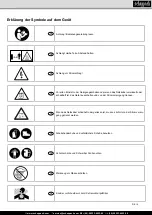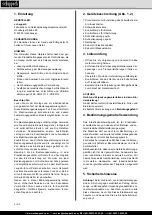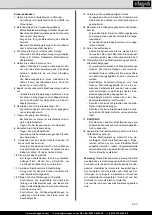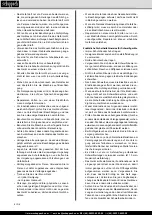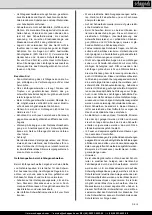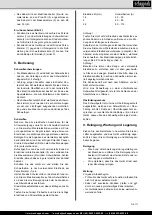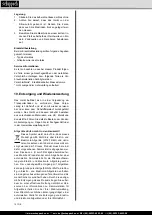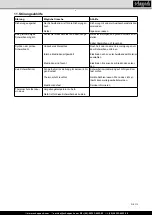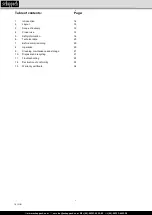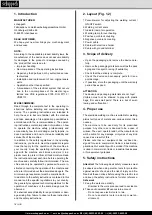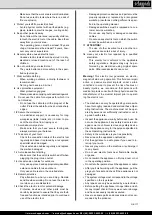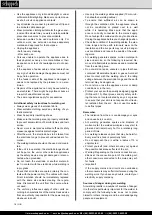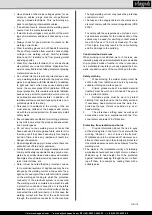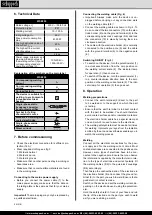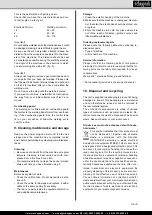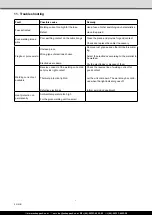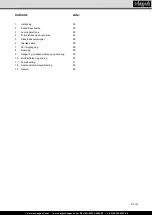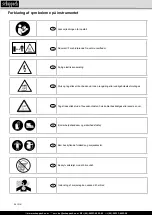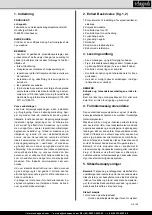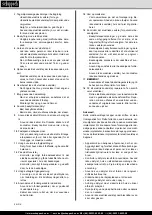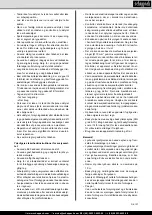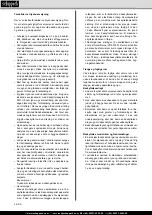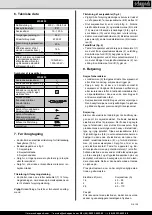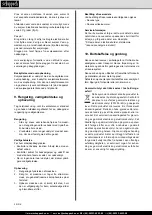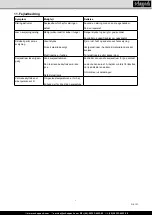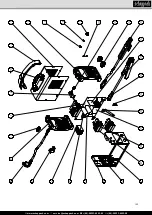
www.scheppach.com
+(49)-08223-4002-99
+(49)-08223-4002-58
www.scheppach.com
+(49)-08223-4002-99
+(49)-08223-4002-58
GB І 19
The high welding current may cause the protective
conductor to melt.
•
The fuses on the supply cables to the mains sock-
ets must comply with the relevant regulations (VDE
0100).
To comply with these regulations, only fuses or cir-
cuit breakers suitable for the cross-section of the
cables may be used (for earthing contact sockets
max. 16 A fuses or 16 A circuit breakers). The use
of too high a fuse may result in the cable burning
and fire damage to the building.
Constricted and wet areas
When working in constricted, wet or hot areas, use
insulating supports and intermediate layers as well as
slip-on gloves made of leather or other nonconduc-
tive materials to insulate your body against the floor,
walls, conductive parts of the machine and the like.
Safety clothing
1.
While working, the welder must protect his
entire body from radiation and burns by wearing
suitable clothing and a face guard.
2.
Slip-on gloves made of a suitable material
(leather) must be worn on both hands. They must
be in perfect condition.
3.
Suitable aprons must be worn to protect
clothing from sparks and burns. A safety suit and,
if necessary, head protection must be worn if re-
quired by the type of work in question, e.g. over-
head welding.
4.
The protective clothing used as well as all
accessories must be in compliance with the “Per-
sonal safety equipment” EU Directive.
Protection from radiation and burns
1.
Provide information about the risk to eyes
at the working site in the form of a poster with the
wording “Caution – do not look at the flames”.
Workplaces are to be screened off wherever pos-
sible so that personnel in the vicinity are protected.
Unauthorized persons are to be kept away from the
welding work.
2.
The walls in the immediate vicinity of stationary
workplaces should not have a light color or a sheen.
Windows up to head height are to be protected
against radiation passing through them or reflect
-
ing off them, for example by coating them with a
suitable paint.
•
Have all work on the mains voltage system, for ex-
ample on cables, plugs, sockets, etc.,performed
only by trained electricians. This particularly ap-
plies to configuring intermediate cables.
•
If an accident occurs, disconnect the welding power
source from the mains immediately.
•
If electric touch voltages occur, switch off the weld-
ing set immediately and have it checked by an ex-
pert.
•
Always check for good electrical contacts on the
welding current side.
•
Wear insulating gloves on both hands for welding.
These offer protection from electric shocks (idling
voltage in the welding circuit), harmful radiation
(Heat and UV radiation) and from glowing metal
and slag spatter.
•
Wear firm, insulated footwear. Your shoes should
also protect you in wet conditions. Opentoed foot-
wear is not suitable since falling droplets of glowing
metal will cause burns.
•
Do not look into the arc with unprotected eyes, use
only a welding safety shield with the proper safety
glass in compliance with DIN standards. In addition
to light and heat, which may cause dazzling and
burns, the arc also gives off UV radiation. Without
proper protection, this invisible ultraviolet radiation
causes very painful conjunctivitis, which will only
be noticeable several hours later. In addition, UV
radiation will cause sunburn-type symptoms on un-
protected parts of the body.
•
Personnel or assistants in the vicinity of the arc
must also be notified of the dangers and provid
-
ed with the required protection; if necessary install
safety walls.
•
Ensure adequate ventilation for welding, particular-
ly in small rooms since the process causes smoke
and harmful gases.
•
Do not carry out any welding work on tanks that
have been used to store gases, fuels, mineral oil or
the like, even if they have been empty for a lengthy
period of time, since any residue will result in a
danger of explosion.
•
Special regulations apply in areas where there is a
potential risk of fire and/or explosion.
•
Welds that are exposed to large stresses and must
comply with safety requirements may only be com-
pleted by specially trained and approved welders.
Examples of such welds include pressure vessels,
rails, trailer hitches, etc.
•
Note: It must be noted that the protective conduc-
tor in electrical systems of appliances may be de-
stroyed by the welding current in the event of neg-
ligence, for example if the earth terminal is placed
on the welding set casing to which the protective
conductor of the electrical system is connected.
The welding work is completed on a machine with
a protective conductor connection. It is therefore
possible to weld on the machine without having
connected the earth terminal to it. In this case the
welding current will flow from the earth terminal
through the protective conductor to the machine.

